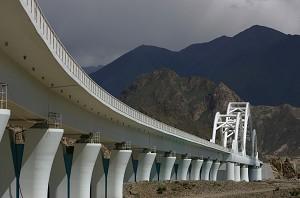Why is China spending so much money on the construction of the Qingzang railroad, a railroad that connects the Qinghai Province and Tibet?
Chinese geologists provide the answer: a large number of valuable mines were found, and their locations dictate the course of the Qingzang railroad. The railroad construction is a decision made by Beijing, as a strategic plan to exploit these resources in the Qingzang highland and to promote the local economy.
What Is So Valuable?
Qingzang railroad is famous because it represents a milestone in railroad construction history. It is over 1,000 kilometers (about 625 miles) long and covers an expanse of highland with an average altitude of 4,000 meters (about two and half miles).
The terrain that the railroad passes through is exceptionally dangerous and complex. The construction is said to be the most difficult so far in history. A number of workers and soldiers have died in the construction process. However, Beijing is determined to build the railroad, and has spent US$3.7 billion so far.
It is very difficult for outsiders to decipher why Beijing paid so much to build a railroad. So what is the real purpose?
Speeding Up Unification Between Tibet and Mainland China
Beijing says that the only reason to build the railroad is to assist the efforts of Tibet’s economy. But overseas critics say that Tibetans will not have a sharp increase of their incomes simply by transporting passengers.
According to observers from The Times of India , the real purpose of building the railroad is to speed up unification between Tibet and the mainland, and to strengthen military forces along China’s borders with India, Burma, and Nepal, so as to handle accidents on the borders and to stop the expansion of the Tibetan independent forces.
Dalai Lama’s Concern
The Dalai Lama, Tibet’s spiritual leader, voiced repeatedly his concern that the railroad construction is the result of the recent discovery of enormous natural reserves in Tibet. He said that unrestrained exploitation would destroy the ecosystem in the Himalayan highland.
His concern was confirmed by Chinese geologists. According to China News Service the construction of the railroad is a key step to utilizing the natural resources and developing the local economy in Tibet—disclosed last week by Meng Xianlai, director of China’s Geological Survey Bureau.
Discoveries along the Qingzang Railroad
China News Service quoted Meng Xiaolai that a national land and resource survey that began in 1999 found 16 large-scale mines along the railroad, including copper, iron, and lead-zinc mines. Roughly five large areas of nonferrous metal mines were identified, with 20 million tons of copper and 10 million tons of lead-zinc.
In Mozhugongka County an extremely large copper mine was located, with reserves of 7.89 million tons, making it the second largest copper mine in China, next to the Dexing copper mine.
Experts say the progress of surveying mineral resources, and their utilization along the Qingzang railroad, will help to boost the local economy and relieve the pressure of resource shortage.
Three More Railroads Are Planned
China is planning to construct three more branch railroads in Tibet within the next ten years, according to The Times of India . One is from Lhasa to Linzi, another from Lhasa to Rikaze, and the third is from Rikaze to Yadong, an important town on the China-India border. Once they are completed, the total length of railroad track in Tibet will exceed 2,000 kilometers (about 1,250 miles).

Friends Read Free